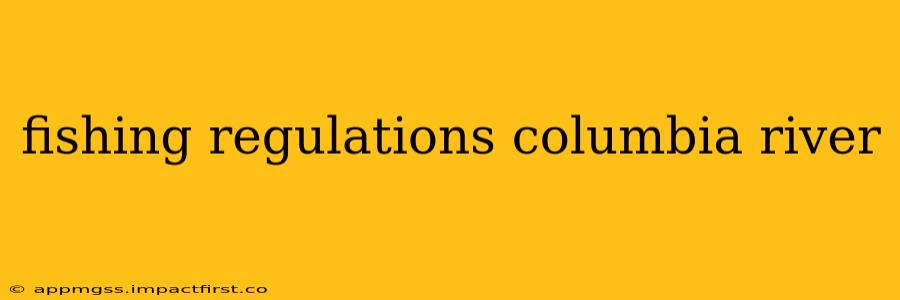The Columbia River, a majestic waterway spanning Washington and Oregon, offers incredible fishing opportunities. However, navigating the diverse fishing regulations across its length can be challenging. This comprehensive guide will clarify the rules and regulations, ensuring you have a safe and successful fishing trip. We'll cover key aspects, answering many frequently asked questions to help you plan your next fishing adventure.
What are the different fishing seasons on the Columbia River?
Fishing seasons on the Columbia River vary significantly depending on the species, location, and time of year. Some species, like salmon, have highly regulated seasons often lasting only a few weeks, while others, like bass, have longer, more open seasons. It's crucial to consult the most up-to-date regulations from the Washington Department of Fish and Wildlife (WDFW) and the Oregon Department of Fish and Wildlife (ODFW) websites. These websites provide detailed season calendars, often presented in interactive maps, specifying opening and closing dates, as well as daily and possession limits for each location. Always check before you go, as regulations can change rapidly.
What are the size and bag limits for salmon fishing on the Columbia River?
Size and bag limits for salmon fishing on the Columbia River are highly variable, changing depending on the species (Chinook, Coho, Sockeye, etc.), the specific area of the river, and the time of year. Again, the WDFW and ODFW websites are your primary resources for this information. These limits are designed to ensure the sustainability of salmon populations and are strictly enforced. Exceeding these limits can lead to significant fines. Note that some areas may have catch-and-release regulations for certain salmon species during crucial periods of their life cycle.
What licenses and permits are required for fishing on the Columbia River?
Both Washington and Oregon require fishing licenses for anyone fishing in their respective waters of the Columbia River. Residents and non-residents have different licensing requirements and fees. You may also need additional permits, such as a Columbia River salmon/steelhead endorsement, depending on the species you intend to target and your location on the river. Always verify licensing needs on the WDFW and ODFW websites before your trip to avoid any legal issues. Failing to obtain the correct permits and licenses can result in substantial penalties.
What are the fishing regulations for steelhead on the Columbia River?
Steelhead fishing regulations on the Columbia River are highly specific and dynamic, much like those for salmon. Regulations vary by location, season, and often by the method of fishing (e.g., fly fishing, bait fishing). The WDFW and ODFW websites provide specific details on size and bag limits, gear restrictions, and catch-and-release requirements. Check the respective websites for up-to-date information.
What are the rules about fishing gear and methods on the Columbia River?
The types of fishing gear and methods permitted on the Columbia River are subject to specific regulations. These vary by species and location. Some common restrictions relate to the number of hooks, types of bait (some live bait is often restricted), and the use of certain fishing methods. The WDFW and ODFW websites provide detailed information on permitted gear and methods. Paying close attention to these details is essential for legal and ethical fishing.
Where can I find a Columbia River fishing regulations map?
The WDFW and ODFW websites both offer interactive maps showing fishing regulations. These maps are often the best way to quickly visualize the regulations for your intended fishing location. The maps typically show boundaries of different fishing zones, and often have color-coded areas indicating specific regulations.
What are the penalties for violating fishing regulations on the Columbia River?
Violating fishing regulations on the Columbia River can lead to significant penalties, including substantial fines, license suspension, and even potential legal action. Enforcement is strict, so always ensure you're fully informed and compliant with the regulations. The specific penalties vary depending on the severity of the violation.
Disclaimer: This information is intended as a general guide only. Always check the official Washington Department of Fish and Wildlife (WDFW) and Oregon Department of Fish and Wildlife (ODFW) websites for the most up-to-date and accurate fishing regulations before your trip. The regulations are subject to change, and relying solely on this guide could result in violations.
This comprehensive guide provides an overview of Columbia River fishing regulations. Remember that responsible fishing practices, including adhering to all regulations, are crucial for preserving the health of this magnificent river and ensuring its resources are available for future generations.
